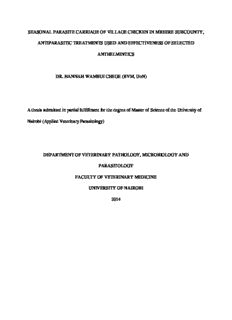
Seasonal Parasite Carriage Of Village Chicken In Mbeere Subcounty, Antiparasitic Treatments PDF
Preview Seasonal Parasite Carriage Of Village Chicken In Mbeere Subcounty, Antiparasitic Treatments
SEASONAL PARASITE CARRIAGE OF VILLAGE CHICKEN IN MBEERE SUBCOUNTY, ANTIPARASITIC TREATMENTS USED AND EFFECTIVENESS OF SELECTED ANTHELMINTICS DR. HANNAH WAMBUI CHEGE (BVM, UoN) A thesis submitted in partial fulfillment for the degree of Master of Science of the University of Nairobi (Applied Veterinary Parasitology) DEPARTMENT OF VETERINARY PATHOLOGY, MICROBIOLOGY AND PARASITOLOGY FACULTY OF VETERINARY MEDICINE UNIVERSITY OF NAIROBI 2014 ii DEDICATION To my loving husband Elijackson Machua, my son Austin, parents; Mr. Joseph Chege Ng’ang’a and Mrs. Jane Wacheke Chege, my sisters; Rehab, Damaris and Rachael and my brother Paul. iii ACKNOWLEDGEMENTS I thank the almighty God for his grace and unfailing love. I am grateful and indebted to my supervisors, Prof. Lilly. C. Bebora, Prof. Ndichu. Maingi and Prof. Paul. G. Mbuthia for their invaluable academic guidance from the initial planning of the studies, the data collection to the preparation of the thesis. I extend my warmest thanks to Prof. Philip. N. Nyaga, Dr. Lucy. W. Njagi and Dr. Jane Githinji for their generous academic assistance in the course of my studies. Special thanks go to RUFORUM for the award of the scholarship and the University of Nairobi for offering me the facilities to do my Masters degree. I acknowledge the Chairman, Department of Veterinary Pathology, Microbiology, and Parasitology for providing laboratory facilities for the study. I am most grateful to Mr. Richard Otieno, Ms Rose Gitari, Mary Mutune and Ms Rebecca Githinji for their continuous support in Parasitology work, Jackson Mwangi Gachoka for his help in photography and Ezekiel Weda, Patrick Mwangi Wahome and Gordon Otieno for their technical assistance. Special thanks to Mrs. Dorcas Nduati for her assistance in data analysis. I express my gratitude to farmers of Mbeere subcounty for allowing me to use their chickens for my studies. This made the study a success. Last, but not least, I would like to express my deepest appreciation to my family members for their love and encouragement during the entire period of my graduate program away from home. Special thanks to my friends, David Kemboi and Simon Migwi for their encouragement. iv TABLE OF CONTENTS TITLE……………………………………………………………………………………………..i DECLARATION ............................................................................................................................ ii DEDICATION ............................................................................................................................... iii ACKNOWLEDGEMENTS ........................................................................................................... iv TABLE OF CONTENTS ................................................................................................................ v LIST OF TABLES ......................................................................................................................... xi LIST OF APPENDICES ............................................................................................................... xv LIST OF ABBREVIATIONS AND ACRONYMS .................................................................... xvi ABSTRACT ................................................................................................................................ xvii CHAPTER ONE ............................................................................................................................. 1 1.0 INTRODUCTION .................................................................................................................... 1 1.2 OBJECTIVES ........................................................................................................................... 4 1.2.1 Overall objective .................................................................................................................... 4 1.2.2 Specific objectives ................................................................................................................. 4 1.3 JUSTIFICATION ..................................................................................................................... 4 CHAPTER TWO ............................................................................................................................ 5 2.0 LITERATURE REVIEW ......................................................................................................... 5 2.1 Poultry industry in Kenya ......................................................................................................... 5 v 2.2 Ectoparasites and endoparasites of poultry ............................................................................... 5 2.2.1 Ectoparasites of poultry ...................................................................................................... 6 2.2.1.1 Poultry lice ................................................................................................................... 6 2.2.1.2 Poultry Ticks................................................................................................................ 8 2.2.1.3 Poultry mites ................................................................................................................ 9 2.2.1.4 Poultry Fleas .............................................................................................................. 11 2.2.2 Endoparasites of poultry................................................................................................... 11 2.2.2.1 Nematodes ................................................................................................................. 12 2.2.2.2 Cestodes of poultry .................................................................................................... 16 2.2.2.3 Trematodes of poultry ............................................................................................... 19 2.2.2.4 Haemoparasites of Poultry......................................................................................... 20 2.3 Sex and age influence on Parasite burdens ............................................................................. 23 2.4 Anthelmintics .......................................................................................................................... 23 CHAPTER THREE ...................................................................................................................... 26 3.0 MATERIALS AND METHODS ............................................................................................ 26 3.1 Study area................................................................................................................................ 26 3.2 Collection of data on chicken parasites and local antiparasitic treatments practiced in the area ....................................................................................................................................................... 29 3.3 Experimental birds .................................................................................................................. 29 3.4 Aging of the chicken ............................................................................................................... 30 vi 3.5 Clinical examination, blood smear preparation and post mortem examination of chicken .... 30 3.6 Processing of nematodes for identification ............................................................................. 31 3.7 Processing of cestodes for identification ................................................................................ 31 3.8 Examination and identification of ectoparasites ..................................................................... 32 3.9 Faecal worm egg and coccidial oocyst counts ........................................................................ 33 3.9.1 Modified McMaster technique ......................................................................................... 33 3.10.1 Experimental design ....................................................................................................... 34 3.10.2 Treatment regimes .......................................................................................................... 36 3.11 Data management.................................................................................................................. 37 CHAPTER FOUR ......................................................................................................................... 38 4.0 RESULTS ............................................................................................................................... 38 4.1 Data on chicken parasites and local treatments used against parasites in Mbeere subcounty 38 4.1.1 Background information .................................................................................................. 38 4.1.2 Management of poultry .................................................................................................... 39 4.1.3 Poultry production constraints ......................................................................................... 40 4.1.3.1 Poultry parasites ........................................................................................................ 41 4.1.3.2 Parasite control .......................................................................................................... 42 4.2 Seasonal prevalence, intensity and identity of ectoparasites and endoparasites ..................... 44 4.2.1 Overall results ...................................................................................................................... 44 vii 4.2.2 Examination of ticks, Seasonal prevalence and intensity of the ectoparasites................. 46 4.2.2.1. Lice infestation in chicken ........................................................................................... 46 4.2.2.1.1. Menacanthus stramineus ....................................................................................... 50 4.2.2.1.2 Menopon gallinae ................................................................................................... 51 4.2.2.1.3 Lipeurus caponis..................................................................................................... 52 4.2.2.1.4 Gonoides gigas ....................................................................................................... 53 4.2.2.2 Poultry ticks ............................................................................................................... 54 4.2.2.3. Poultry flea ............................................................................................................... 55 4.2.2.4. Poultry mites ............................................................................................................. 56 4.2.2.4.1. Dermanyssus gallinae............................................................................................ 57 4.2.2.4.2 Cnemidocoptes mutans ........................................................................................... 58 4.2.3 Seasonal prevalence of endoparasites .............................................................................. 60 4.2.3.1 Seasonal prevalence for gastrointestinal nematodes ..................................................... 60 4.2.3.1.1 Caecal worms ......................................................................................................... 61 4.2.3.1.1.1 Heterakis species ................................................................................................. 62 4.2.3.1.1.2 Heterakis isolonche ............................................................................................. 66 4.2.3.1.1.3 Heterakis gallinarum ........................................................................................... 67 4.2.3.1.1.4 Subulura brumpti ................................................................................................. 67 4.2.3.1.2 Gongylonema ingluvicola .......................................................................................... 68 viii 4.2.3.1.3 Tetrameres americana.............................................................................................. 69 4.2.3.2 Seasonal prevalence of cestodes ................................................................................... 70 4.2.3.2.1. Raillietina species .................................................................................................. 72 4.2.3.2.1.1 Raillietina echinobothrida ................................................................................... 72 4.2.3.2.1.2 Raillietina tetragona ............................................................................................ 74 4.2.3.2.2.2 Davainea proglottina ........................................................................................... 75 4.2.3.2.2.3 Hymenolepis cantaniana ..................................................................................... 76 4.2.3.2.2.4 Choanotaenia infundibulum ................................................................................ 76 4.2.3.3. Seasonal prevalence of coccidial oocyst counts ........................................................... 77 4.2.3.4 Seasonal prevalence of haemoparasites ........................................................................ 77 4.2.3.4.1 Plasmodium gallinaceum ....................................................................................... 79 4.2.3.4.2 Leucocytozoon schoutedeni .................................................................................... 80 4.2.3.4.3 Aegyptinella pullorum ............................................................................................ 81 4.2.3.4.4 Eperythrozoon species ............................................................................................ 82 4.3 Effectiveness of selected anthelmintics used on the village chicken ...................................... 82 CHAPTER FIVE .......................................................................................................................... 88 5.0 DISCUSSION, CONCLUSIONS AND RECOMMEDATIONS........................................... 88 5.1.1 Data on chicken parasites and local treatments used against them in Mbeere sub-county .. 88 5.1.2 Seasonal prevalence, intensity and identity of ectoparasites and endoparasites .................. 90 ix 5.1.3 Effectiveness of selected anthelmintics ............................................................................. 101 5.2 CONCLUSIONS................................................................................................................... 102 5.3 RECOMMENDATIONS ...................................................................................................... 103 CHAPTER SIX ........................................................................................................................... 104 6.0 REFERENCES ..................................................................................................................... 104 7.0 APPENDICES ...................................................................................................................... 115 x
Description: